I have related parts of this tale to various people over the years. Some were fascinated, others bored to tears. If you might be one of the former, please read on and join me in this trip down memory lane...
I started with an interest in electronics. My father was an electronics engineer, and passed along a fascination with designing and building things. Blowing things up was entirely my doing, and I can't blame him for that in the least. In High School (Mira Costa High School in Manhattan Beach, CA), I enjoyed wood shop, chemistry, and of course electronics shop. My teacher (Mr Scott) had a way of getting all kinds of neat (usually old) stuff for us to take apart and play with.
One of these toys was an old Bendix G-15 computer which used vacuum tubes, rotating drum for storage, and core memory (ferrite beads woven into a matrix of wire). Click the core picture for more information:
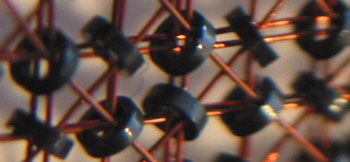

For communication with the operator, a keyboard and printer. The keyboard/printer was hooked to a large flat box on the floor which contained dozens of relays. The case for the main computer was about the size of a large refrigerator, only a bit taller.
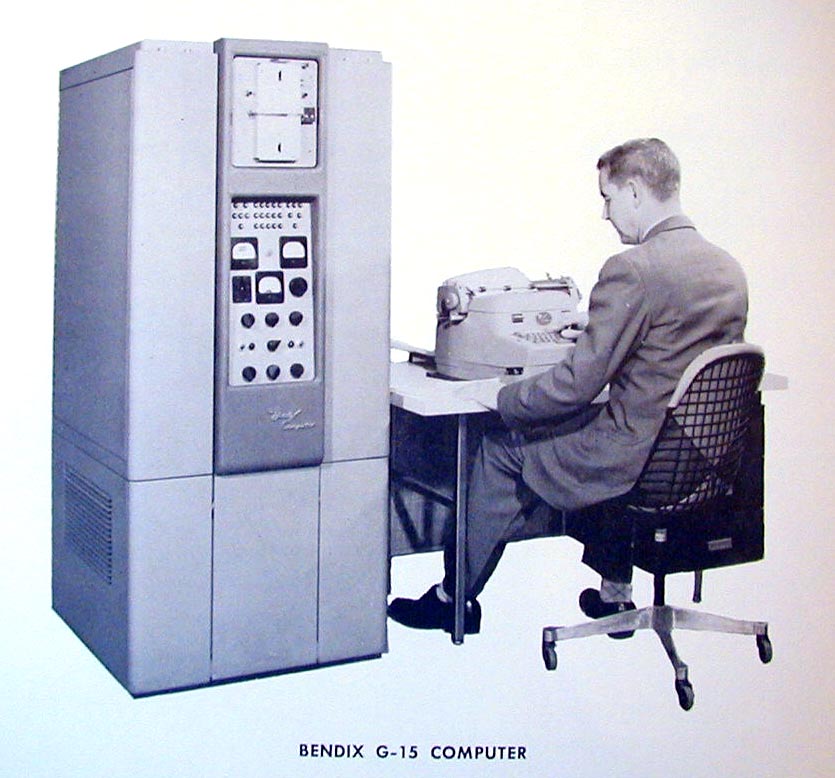
The whole thing was a joke, even back then! It was so unreliable, that if you started to get odd responses, you would look up and tell whoever was leaning against the case to knock it off. Relays in the keyboard box would frequently stick, which lead to dead keys on the keyboard, or certain characters that wouldn't print, or would print as a different character. I didn't play with this very much, and it didn't last long before being torn apart by seniors to try and use some of the innards for other things.
In 1977, Mr Scott acquired an MITS Altair 8800. This was one of the first "personal computers" (though not the absolute first one), and it was based on the Intel 8080 processor.
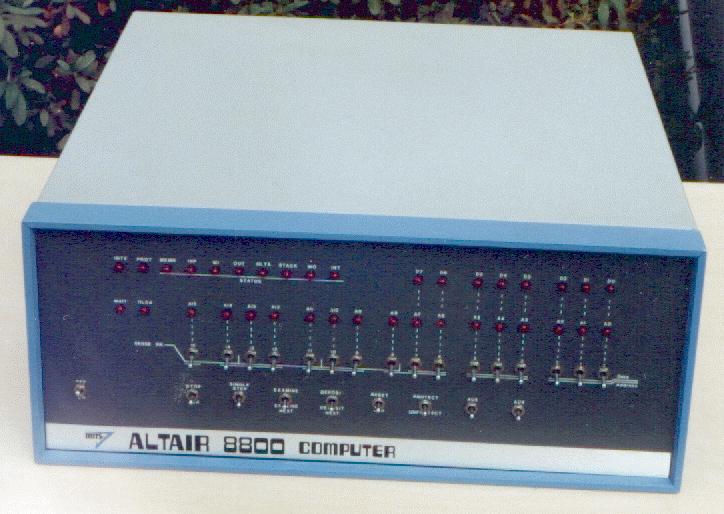
We had fun writing BASIC and assembler programs on it, and building circuits to attach to it for various projects. In order to start this computer, you had to key in a "bootstrap" (in binary) using the switches on the front panel. A few months later, the machine was upgraded with a "bootstrap in ROM" (BIOS), and then you just had to key in the base address of the loader, and hit execute. Much easier!
One of the goofy projects with this machine was to try to hook it up to the rotating drum memory from the GE computer. This was going fairly well until some jerk poked at one of the many heads that ran down the length of the drum while it was running. The head moved down a bit, touched the drum, and carved a brilliant wide scratch into it, ruining the whole thing in one quick motion.
About that time, it began to dawn on me that I enjoyed programming more than building circuits. There was more flexibility and you could be more creative. Also, you didn't burn your fingers with a soldering iron all the time!
Local electronic stores began carrying computer kits and parts, and a chain of stores called "The Byte Shop" appeared. The closest to me was the "The Byte Shop of Lawndale", owned by Dick Moule. The store had a small staff. Ted, Roger, and Glenn were the "senior geeks", and Terry was the "token hippy". I can't remember the name of the store manager. They were all great guys and I really enjoyed working with them.
For a Junior in high school, this was a great opportunity. I rode my bike over there daily and learned to use all of the various computers that they sold. I wrote demo software for most of them which the store could leave running on the computers so shoppers could see them actually doing something. Occasionally, I did some sales as well as programming.
Here are some of the computers I used on a regular basis at the store:
| Altair 8800 |
 |
|
IMSAI 8080
More reliable and popular than the Altair.
It was also better looking, and the switch
positions were easier to read.
|
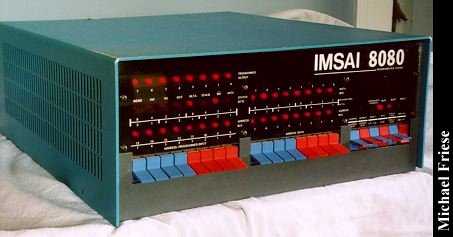 |
|
Apple II
|
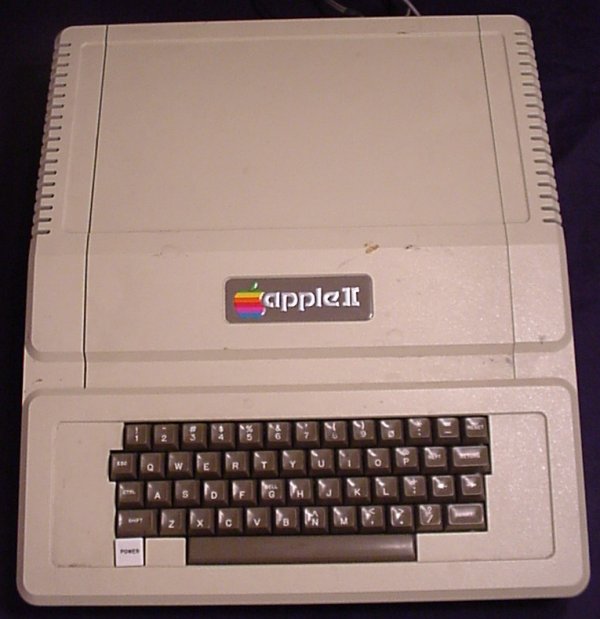 |
|
Commodore Pet
These had a built-in cassette for saving programs and a horrible little keyboard
|
 |
|
Intecolor (Compucolor)
Shown here with the infamous "floppy tape"
(aka: 8-track)
|
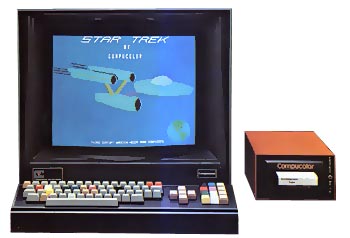 |
|
Processor Technology SOL Terminal 20
Yes folks, those are real walnut side panels.
This was probably the most elegant one.
|
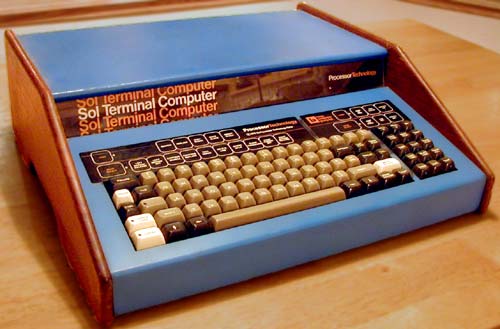 |
|
Alpha Micro AM-100
It took two S-100 boards to fit the chips for the CPU
The case was a standard S-100 chassis and varied by dealer - frequently sporting the dealer name.
Sometimes, IMSAI chassis were used.
|
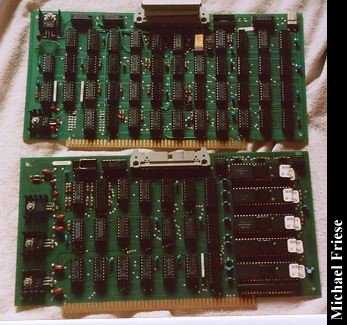 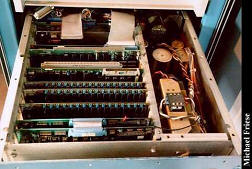 |
| Southwest Tech 6800 |
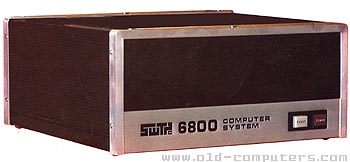 |
|
Atari 400
Another horrible keyboard. They fixed this with the Atari 800
|
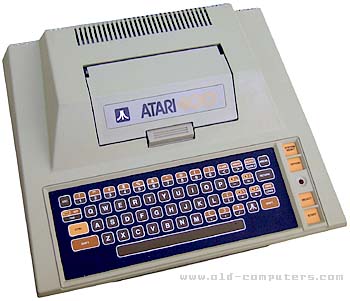 |
|
PolyMorphic 8813
This was one of my favorites. The OS was very nice. They had special memory addresses you could call to do various system functions. They called these "wormholes"
|
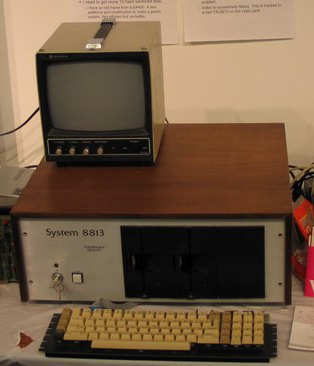 |
Most of these computers were boxes with an attached, or integrated keyboard. The CRT display was separate. This display was either a small TV which hooked up to an "RF Modulator" (converted the video signal from the computer to channel 3), or a monitor which took NTSC video directly from the computer. People used black and white security monitors for this, in a lot of cases.
They typically had 4K, 8K, or 16K of RAM (yes, that's Kb, not Mb). The early ones had an external cassette interface so you could save your programs to a JC-Penney cassette recorder. One of the more popular cassette interfaces was the Tarbell interface, designed by Don Tarbell.
The most hilarious storage system was the "Floppy Tape" - an 8 track tape system! The CompuColor 8001 was the computer which used this. It was incredibly unreliable, and so when the CompuColor II came out, they replaced it with a 5 1/4" disk.
When floppy disks came out, they were 8". Later, 5 1/4" disks came out, followed by the 31/2" disks:
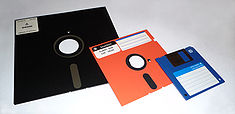
One of the niftiest 8" floppy drives was the Persci disk drive. It was very fast, but you never wanted to move the drive. Ever! If you so much as moved it across the room, it would stop working and had to be realigned (yes, I am serious). But when it worked ... it beat all the others hands-down. Also, it was the first drive with electric eject. To insert the floppy, you just stuffed it into the slot. To eject, you pressed a button and it ejected itself with a whining noise. Very high tech.
One of the projects the store had was a natural-language (meaning you typed in "english like" queries) database called Sindex (syntactical index), headed up by Glenn Wood. This was done on the Alpha Micro computer, in WD-16 assembler. The AM-100 had a DEC multi-chip CPU which used the PDP-11 instruction set. This was a "multi-user" computer, which could support several "dumb terminals", connected with serial cables to the main box. Now this was a REAL computer! I quickly began to focus on this system as it seemed to have the most power and potential of the microcomputers which were available at the time. Here's a link to a review. Here's a link to a really nice page about all the various Alpha Micro models over the years.
The "dumb terminals" we used were just that - dumb. They had very little inside other than a display controller, keyboard controller, CRT, and a serial RS-232 interface. Here are some of the ones I used: ADM3A, DEC VT-100, Ann Arbor Ambassador, Soroc, hazeltine 1500, Wyse 50
People always got confused by these monitors because they were made by a different manufacturer than Alpha Micro. We'd get calls all the time "yea, so my Wyse computer isn't working right". I suppose it's the same today with PC computers. Tech support gets calls with "my Hazeltine computer isn't working". Some things never change, I guess.
Of these, the ADM3A was the goofiest looking. It was all rounded with a bakelite case.
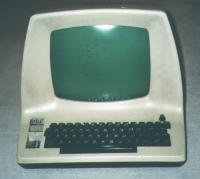
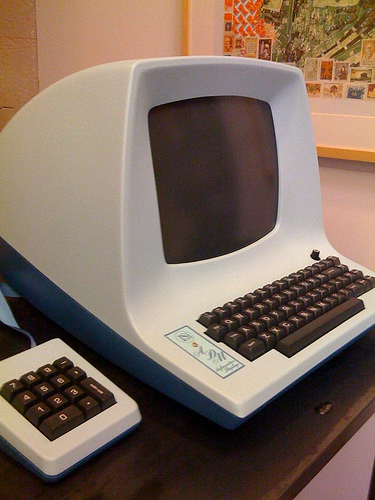
The Soroc terminal was really cheap feeling and not great to use. It was named after a certain brewery (hence the logo). The name and logo at least live on today as one of Soroc's major distributors has adopted it, though they now no longer distribute these machines:
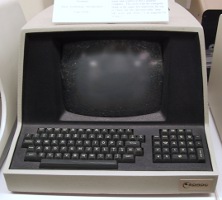

The most popular terminal though, was the Wyse 50. For many years you saw these all over the place; in banks, stores, and business in general:
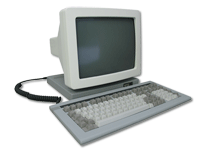
My Focus Narrows a bit
After I had been working on the Sindex project for a while (admittedly not really getting very far with it as it was very much a "one man show" for Glenn, and the code base was excessively complicated), I was moved to an AlphaBasic project. Alpha Micro had an accounting package written in their BASIC variant, and Dick Moule had obtained the rights to modify it and do his own spin-off. There were 3 of us on the team for this project. James Balcom was the project lead, and the one who actually knew something about accounting. Eric Storm and I were the coding monkeys. The main thrust of the project was to retrofit profit center accounting into the system. It was quite tedious as every single module had to be modified, and sometimes the modifications were quite extensive. I wrote several "xcall" routines (assembler subroutines that could be called from BASIC) to speed up certain slow parts.
In the evenings, I'd teach a BASIC (programming language) class to customers who had purchased computers from the store. I'm quite sure that very few of these folks were ever really successful at using the computers they had paid so much money to acquire. I have found over the years that programming is easy for some people, and hard for others. It's something about the way your brain is wired, and curiously has nothing to do with intelligence as far as I can tell. Only 1 or 2 students in these classes were wired correctly, and "got it". For everybody else, it was very difficult.
I was taking classes at El Camino College at the time, and I saw the same thing there. At the time, data processing was not handled well by the college. It was all new and they didn't know what to do with it. They thought "computers use numbers, let's have the Math teachers deal with it". In retrospect, that's not necessarily the best fit. These poor profs were learning the material one week, and presenting it to the class the next. It didn't take me long to catch on to this, and as I could simply read the books myself, I dropped out. I found that by learning on my own, I could progress at a pace much faster than the classroom environment.
El Camino did have a nice computer lab though. They had an IBM 360 mainframe, and we'd use punch-cards to input our programs for processing. The operator would take our card decks at the window, and later give us back our deck with our printout. It was all very civilized, but slow. The college later purchased an IBM 4033 which replaced the 360. It had terminals you'd use to interact with it, and the keypunch machines were phased out.
Part-way through the AlphaAccounting project, Dick decided to spin off a new company called CompuWest which would sell Alpha micro hardware and software. Sindex and the accounting package were the main products, but consulting, sales, installation and repair were part of it too. Offices were rented in Century City in the Century Plaza Towers (the twin triangular buildings), on the 42nd floor. Alan Porter (from Mission Control) was brought on board as the CTO and senior programmer. The view was fantastic from my office, with floor to ceiling windows!
After CompuWest, I did consulting for various companies, one of which was Dataccount, a payroll/HR service company in Torrance. They wanted their customers to be able to key in their data on these odd little HP 9830 machines, and then be able to send the data in for processing on the company's mainframe (COBOL based). This saved a bunch of time and money over using a service to do the data entry. The machine had BASIC built in, and a tape deck for saving/loading data. I was contracted to write the code. Here's what the machine looked like:
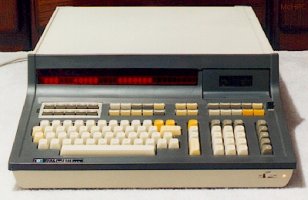
All this time, I was writing software at home for the AlphaMicro. I had a terminal driver "live swap" utility, a serial communications package called QEDSND/QEDRCV, some other utility programs and a games package (using just keyboard characters because most "dumb" terminals didn't have any sort of graphics capability... or even color!). It was quite disappointing when I did shows because while I was thrilled with the cleverness of the utilities, the games package always got the most attention. In that package was "Breakout", "Road race", "UFO shoot", and "Monopoly". My Pinball game never actually made it to market, though it was really cool, if I do say so myself.
One of the big problems we had was memory. The AM100 could only use 64K of memory. The system used up about 32K, so if you were careful, you got 32K of user memory, and if you let your system size grow too much and it went over the 32K mark, then it ate the next 16K so you'd only have 16K for user memory. Of course, back then, we could do a LOT in that much memory. The Alpha had a memory paging feature that let you install memory in banks so that assuming you had a 32K user area, you could have multiple user areas of 32K each which lived in the same space, but only one was turned on at a time by the operating system. This let you put more than one user terminal on the machine, and was key to its success. One computer would run an entire office full of terminals.
Still, 32K isn't a lot to work with, and so our AlphaBasic programs would run out of room. To combat that, we broke them up into smaller programs, and "chained" back and forth between them with various methods of preserving data from one to the other. I came up with a way of doing an "overlay" by using an assembler language "xcall". You'd create modules for your program, and my system would load them in as needed, preserving the environment so you didn't worry about having to find a way to keep your data around like you did when you "chained" to a different program. This was a big step forward, and allowed much bigger programs to be written, as long as you "played by the rules" of the overlay system. This eventually got incorporated directly into Dravac's basic pre-processor (more about that later).
Disk space was beginning to be a problem
With all this business usage going on, floppy disks began to seem a little small. Control Data (CDC) was big in data centers for huge multi-platter hard disks and tape drives. They came out with a line of physically smaller units which didn't have to be in a controlled datacenter environment. The first one we saw was the "CDC Hawk" drive. It had a whopping 10MB of disk space! Wow, we thought, that's a LOT of typing. We'll NEVER fill this up. Heh heh, Heh heh... Anyhow, this unit had a removable disk "platter" - a thick blue round plastic case with a rigid metal disc inside, which had a metallic oxide coating (like the coating on magnetic tape). The platter was 15", and with the plastic case, it was about 2' in diameter, and about 4" thick. This was placed into the top of the Hawk and latched in place, prior to being "spun up" to operating speed. The removable platter was 5MB and there was a fixed platter inside providing the other 5MB. The whole thing was very loud, and weighed about 75lb, plus the cabinet weight.

Later, CDC came out with their Phoenix drive. This was a 19" rack mounted unit, about a foot high and 30" deep. It weighed in at about 85lb, and had 8 fixed disk platters in addition to a removable platter. Each platter was 10MB. This provided a mind boggling 90MB of storage capacity. We all knew for a certainty that while the Hawk drive was big, it was actually possible to fill it up, but this one would never suffer that problem. Yea, right. For those of you who aren't geeks, most personal computers in 2010 come with 70G or larger hard disks. That is 70,000MB. Old 3 1/4" floppy disks are 1.44MB. So, these days 90MB of storage would be a joke. One JPG image typically takes 45M of space.
The Phoenix wasn't as hardy as the Hawk though. Most owners found out very quickly that actually changing that removable platter, as the glossy brochure led you to believe you could do, was a very risky thing to do. A lot of the time, when you did that, a small speck of dust would get into the system and you'd get a head crash. Bye bye data, on ALL platters, and it'd be down until you completed a rather expensive repair job which involved replacing the damaged platter and the associated heads.
Stuff I had at home
By 1982, I had (much to my Mother's chagrin) a room full of noisy computers. I had two CompuColor computers (one with floppy tape, the other with a floppy disk, but both the 8001 case style), and an Alpha Micro AM-100T system with two modems, a Hazeltine 1500 terminal, and a large (very noisy) 35MB Priam hard disk unit.
We didn't have networks or the internet back then, but the phone company had this thing called "circle dialing" which let you pay a flat fee for calls into a certain geographic "circle" of numbers. These were "zone calls" otherwise, and while not truly long distance, they were expensive. I had "circle calling" to Hal Tobin's real estate office in Huntington Beach. Alan Porter had "circle calling" from his house in LA, to my house in Redondo Beach. Alan would call in to one of my 2400 baud Multi-Tech modems, log on to my Alpha Micro, then hop out on the other modem and call Hal's Alpha Micro at the office. He'd then log in there and work for as long as he wanted without having to pay toll calls. We loved getting around the phone company this way. Also, we were impressed with ourselves because we had 2400 baud, and most other people at that time had only 1200 baud.
The CompuColor computers were heavily used for industrial process control applications. Nuclear power plants used them extensively. This was more than a little scary, because they were very badly designed and could be unreliable. One of the worst parts was the power supply. There was a single regulator transistor which was very over-stressed. It would get burning hot to where you couldn't touch it, and that was normal operation. Needless to say, at some point, it just failed. When that happened, the 5V supply to all the S-100 circuit boards shot up to 15V! This is what we call "very bad". The driver chips on the boards would all go like popcorn, sometimes actually "cratering" and blowing a chunk out of the top of the integrated circuit package. Back then, we repaired computers by replacing chips and so forth, not just swapping out cheap boards like we do today. So, this was expensive and tiresome. I replaced my two computer supply regulators with military-spec transistors which are rated for higher loads and temperature. They worked flawlessly until I got rid of the machines several years later.
Emulation software has since been written so that modern PC systems can be used, and still run the same process control software. It wouldn't be surprising for this stuff to still be in use at powerplants around the US.
Not all of my CompuColor hacking was successful though. Since the "floppy tape" was so awful, I decided to try to hack into it and wire it to a cassette deck so I'd at least be on par with all the other folks who were saving data to cassette. You'd think that was a simple thing to do, and so did I, but I never could get it to work reliably. Perhaps the floppy tape controller board was just plain flawed, and not the 8-track mechanism as I'd assumed.
Speaking of backups, Alpha Micro had a rather unusual backup system. The AM1000 had it built in, and the other systems had a special interface board. You'd hook your computer to a VHS video recorder, and it would record data as blobs of black and white (if you were to watch the results of your recording on a TV screen). It was slow, but allowed you to back up a lot of data on a single tape.
Many years later, I acquired Hal Tobin's AM100/L based system (motorola 68000 CPU), complete with Phoenix disk drive. On top of the mini-rack enclosure below, you can see an AM1000 CPU and the base of one of my Wyse terminals. In the mini-rack (which had a smoked plexi door to cover things up and make it look "office like", you'll see the phoenix disk drive on the top (the white portion), and the Alpha Micro on the bottom (the blue portion). Behind that blue panel was an S-100 chassis, filled with CPU, memory, and I/O cards.
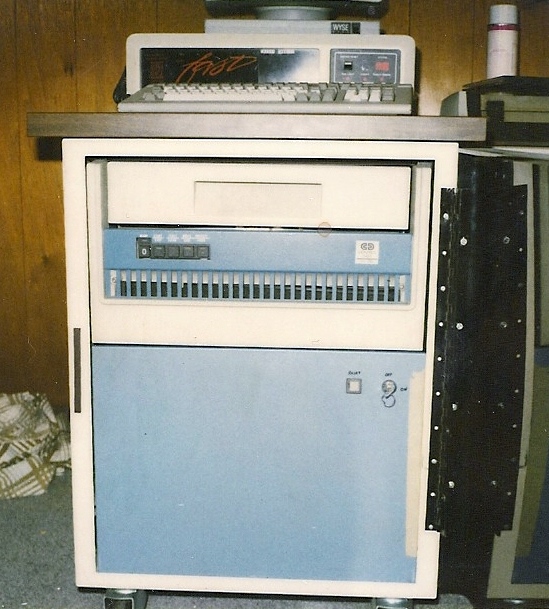
I ran it for a while, but by then it was aging, slow, loud, bulky, and I had an AM1000 which was much better for development as it was much smaller and quieter:


To do:
apple II
consulting: real estate, Lehigh Oil, terminal emulation, atari-800,
d/os: d/vue, wildcard processor, copy, rename, disk optimizer, print spooler
ANDI & TSASS